For the inspiration of Oliver and Harry Potter, we decided to make a wand for our final project. It was a dream of the child side of me, as a loyal, young believer of the wizard world to make the wand into a physical interactive thing that even common people can hold. It is so wonderful to have the opportunity of fulfilling that fantasy as a course final project.
The idea is very simple: use an accelerometer to detect the angle of the wand so that images on the screen can move accordingly, and use sound recognition to catch the spells the users said. We also liked to attach an LED on the top of the wand to add the interactive effects, such that when the user calls different spells different colors of light would light up accommodatly. For example, the classic easy spell “Lumos” would be accompanied with a white light lighting on, which is exactly like the spell effect.
We spend time discussing the idea and made a sketch plan for what we would do. Here is a photo of what we note down:
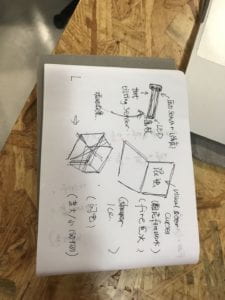
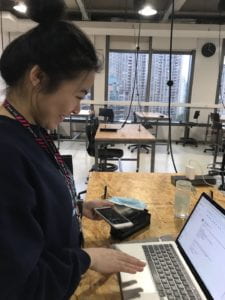
We thought of some spells: Lumos, Nox, Fireworks and other natural elements that can make cool effects. The original idea was to use a mysterious misty cloudy video as the background for when there is no spells activated, but in the end we just left it as black.
On the user test Firday we only managed to finish the voice recognition part using the library Oliver introduced to us, which would call out some animation we developed on the resources found the internet (firework, stars and fire). In this stage the user could only interact with the Processing page through sound, mouse press and key pressed, in the noisy environment of the user test where the voice was hard to be recognized and the wand no where to be seen, the process hardly look magical at all. But I was confident that it would look a lot better with a real wand and the full screen hiding all of the codes. The suggestions that the users gave was to do exactlt those, and perhaps add a pair of earphones/microphone so that the spells are easier recognized.
A lot of work was done since then. We spent two afternoons in the IMA lab developing more effects for spells (Lumos, Nox and Avada Kedavra), finding sound resources and video resources, 3D printing and coding for the accelerometer. In the process some students came by and gave valuable suggestions (adding Avada Kedavra was an advice from Albert), we also recieved a lot of help from Oliver, Andy and the unemployed student worker Steve:) Here are some photos and videos of that process:
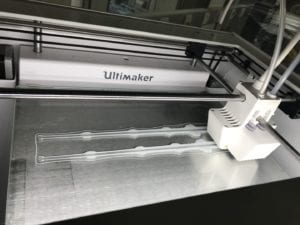
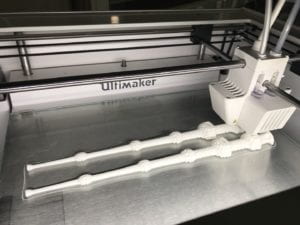
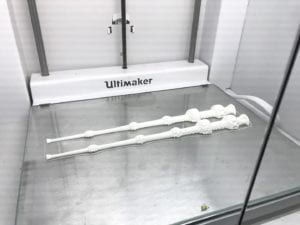
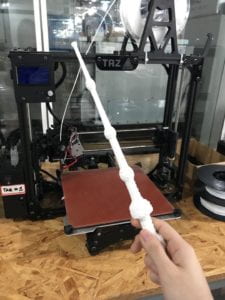
Christine did the video editting and the poster and I did the accelerometer coding and circuits. We did the physical fabrication and animations together. And this is the final result:
It was so cool to see it finally work! We plan to play the Harry Potter theme on Christine’s computer, which will make the experience even more immersive.
Some failures we came across in the way:
There is no big failures that we bumped into, as when we first came up with the idea we gone through the validity of every steps. So even if the end result is slightly plainer than we first imagined, it’s not dramatically off track. However, we did faced a problem when we try to attach the LED on the point of the wand as we planned. It turns out that the wand is too thin and the tunnel we left in the middle for the wires is too small for them to fit, especially if we want to fit it a four-legged color-changing LED. But if we don’t use that, the LED would only have a none-white color which doesn’t fit our scheme. Technically there is a way to do it: to peel off the skin of two wires and place them inside the wand, and leave two other wires outside circling the wand like vines. But time was limited and we didn’t resort to try it. In the end we used a bit of hot glue to create a pointy end. Also, the accelerometer was attached at the end of the wand, when it would be more sensitive and reasonable to place it somewhere near the pointy end. But due to the size of it and the shape of the wand we thought that is the best thing we could do.
Possibilities of Improvement:
It would be very cool to make it wireless with bluetooth connection! Also, the accelerometer can be more accurate, and it would be very interesting to add a trajectory fuction, so that it can recognize both the voice and the user’s gesture with the spell, which will make it a VERY real wand. It would also be more engaging if there are interaction design between the users.
I really hope the new game developed by the Warner Bothers would have a physical wand like this.
Some Resources we borrowed:
The videos of Expecto Patronum come from the patronus test of Pottermore.com;
the shooting star animation was built on https://www.openprocessing.org/sketch/41149/#ixlab-oliver;
the fire animation was built on https://processing.org/discourse/beta/num_1260921434.html;
the firework animation was built on https://cs.brynmawr.edu/Courses/cs110/fall2012/section001/examples/week13/Fireworks/applet/index.html;
we used the speech recognition library from here: https://www.notion.so/Speech-Recognition-e6dc1c6d1ded4e69953ad111c70603df;
the sounds are downloaded from https://www.epidemicsound.com/sound-effects/?_us=adwords&_usx=11440412813_sound%20effect&gclid=CjwKCAiAz4b_BRBbEiwA5XlVVtP5fJd-JS6HTcLLxbNUdSK377FWaFN0x0YNul6WjIxf8v2J6CNAFxoCowwQAvD_BwE.
Thank you Oliver for a fantastic semester!